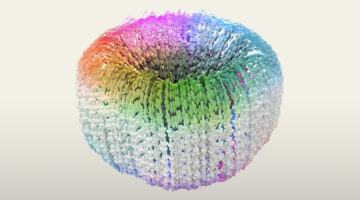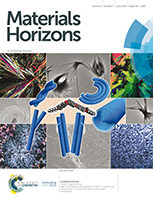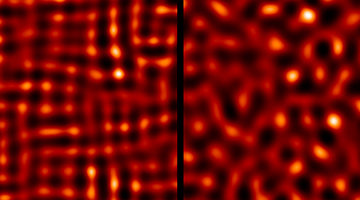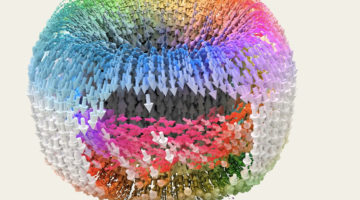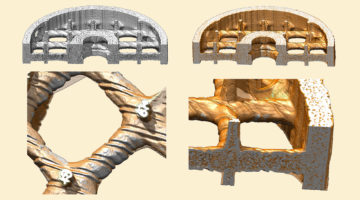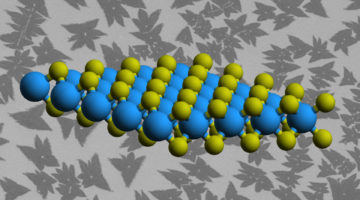Researchers demonstrated that polar skyrmions—cousins of magnetic skyrmions but comprising swirls of electric dipoles instead of spins—exhibit chirality in a material with electrically switchable properties. Control of such phenomena could one day lead to low-power, nonvolatile data storage as well as to high-performance computers. Read more »![]()
![]()
Heliconical-layered nanocylinders (HLNCs) – hierarchical self-assembly in a unique B4 phase liquid crystal morphology
Morphology is of critical importance for molecular crystals, drug molecules, alloys, and elements in the periodic table. We here demonstrate how very subtle structural changes in a set of bent-core liquid crystals lead to rather complex hierarchical superstructures driven by changes in molecular conformation. Read more »
Superconductor Exhibits “Glassy” Electronic Phase
Researchers discovered that electrons in a high-temperature superconductor can exhibit a new type of collective behavior that is more “glassy” (disordered) than expected. The study provides valuable insight into the nature of collective electron behaviors and how they relate to high-temperature superconductivity. Read more »![]()
![]()
Infrared Light Reveals Microstripes at Insulator-Metal Transition
In this study of a current-driven insulator-to-metal transition, a distinctive stripe pattern develops between the insulating and metallic phases. The work reveals remarkable new features of electrically induced insulator-to-metal transitions in materials with potential applications in energy-efficient memory and transistor devices. Read more »![]()
Electric Skyrmions Charge Ahead for Next-Generation Data Storage
Researchers have observed chirality for the first time in polar skyrmions in a material with reversible electrical properties. The combination of polar skyrmions and these electrical properties could one day lead to applications such as more powerful data storage devices that hold information even after a device has been powered off. Read more »
Evidence of a Long-Predicted Magnet
Half a century ago, theorists proposed a novel way for materials to produce a magnetic field. Now, scientists have discovered a uranium compound that bears out that long-ago theory—a new type of magnet that holds promise for enhancing the performance of data storage technologies. Read more »
The Best Topological Conductor Yet: Spiraling Crystal Is the Key to Exotic Discovery
Researchers have discovered the strongest topological conductor yet, in the form of thin crystal samples that have a spiral-staircase structure. The realization of so-called topological materials—which exhibit exotic, defect-resistant properties and are expected to have applications in electronics, optics, quantum computing, and other fields—has opened up a new realm in materials discovery. Read more »
Absorber Captures Excess Chemotherapy Drugs
Researchers have designed a biomedical device for absorbing excess chemotherapy drugs during cancer treatment, characterizing the active surface layer using x-ray microtomography. The work opens up a new route to fighting cancer that minimizes drug toxicity and enables personalized, targeted, high-dose chemotherapy. Read more »![]()
![]()
A Nanoscale View of Defect Effects on Band Structure
In the first comprehensive study at the ALS involving nanoARPES, researchers probed the electronic effects of defects in monolayer tungsten disulfide at the nanoscale. The extremely small scale of the measurements makes nanoARPES a great discovery tool that will be particularly useful for understanding new materials as they are invented. Read more »
Scientists Take a Deep Dive Into the Imperfect World of 2D Materials
Researchers combined a toolbox of techniques to home in on natural, nanoscale defects formed in the manufacture of monolayer WS2, measuring their electronic effects in detail not possible before. The latest result marks the first comprehensive study at the ALS involving nanoARPES, which researchers enlisted to probe the 2D samples with x-rays. Read more »
- « Previous Page
- 1
- …
- 13
- 14
- 15
- 16
- 17
- …
- 26
- Next Page »
